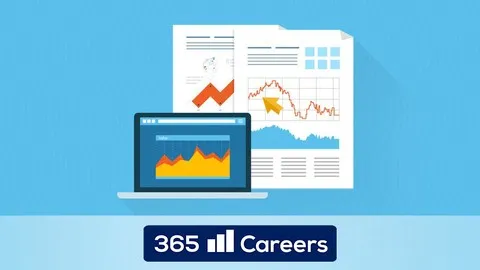
The Complete Financial Analyst Course 2022 
This course is the perfect way to become a successful Financial Analyst. Learn how to work comfortably with Microsoft Excel and PowerPoint, format spreadsheets in a professional way, create professional charts, understand Accounting and Bookkeeping principles, analyze a company's performance, assess project feasibility, and much more. Take the first step towards a successful career in Financial Analysis and enroll in the Complete Financial Analyst Course 2022 today! ▼
ADVERTISEMENT
Course Feature
![]() Cost:
Cost:
Paid
![]() Provider:
Provider:
Udemy
![]() Certificate:
Certificate:
No Information
![]() Language:
Language:
English
![]() Start Date:
Start Date:
Self Paced
Course Overview
❗The content presented here is sourced directly from Udemy platform. For comprehensive course details, including enrollment information, simply click on the 'Go to class' link on our website.
Updated in [June 30th, 2023]
The Complete Financial Analyst Course 2022 provides students with the skills and knowledge to work comfortably with Microsoft Excel and PowerPoint. Students will learn how to format spreadsheets in a professional way, work with large amounts of data, understand accounting and bookkeeping principles, build a company’s P&L and Balance Sheet from scratch, perform financial statement analysis, calculate liquidity, solvency, profitability, and growth ratios, understand 10-K reports, assess whether a project is feasible through the Net Present Value Technique, calculate a complete loan schedule, understand the difference between variable and fixed interest rates, perform industry analysis, understand what drives a company’s value, know how to analyze a business, and create professional company presentations in PowerPoint. With the completion of this course, students will be well-equipped to become successful Financial Analysts.
[Applications]
Those who have completed The Complete Financial Analyst Course 2022 can apply their knowledge to a variety of tasks. They can use Microsoft Excel to format spreadsheets in a professional way, work with large amounts of data, and create professional charts. They can also use their knowledge of accounting and bookkeeping principles to build a company’s P&L and Balance Sheet from scratch. Additionally, they can use their understanding of 10-K reports to assess whether a project is feasible through the Net Present Value Technique, calculate a complete loan schedule, and understand the difference between variable and fixed interest rates. Furthermore, they can use their knowledge of industry analysis to understand what drives a company’s value and how to analyze a business. Finally, they can use Microsoft PowerPoint to create professional company presentations.
[Career Paths]
One job position path recommended to learners of The Complete Financial Analyst Course 2022 is a Financial Analyst. Financial Analysts are responsible for analyzing financial data and providing advice to businesses and individuals on how to best manage their finances. They use a variety of tools and techniques to assess the financial health of a company, including financial statement analysis, ratio analysis, and cash flow analysis. They also provide advice on investments, budgeting, and other financial matters.
The development trend of Financial Analysts is very positive. With the increasing complexity of the global economy, the demand for Financial Analysts is expected to grow significantly in the coming years. Companies are increasingly relying on Financial Analysts to provide accurate and timely financial advice, and the role is becoming increasingly important in the corporate world. As a result, Financial Analysts are expected to be in high demand in the near future.
[Education Paths]
The recommended educational path for learners of this course is a Bachelor's degree in Finance. This degree will provide learners with a comprehensive understanding of financial principles, theories, and practices. It will also equip them with the skills and knowledge necessary to analyze financial data, develop financial strategies, and make informed decisions.
The Bachelor's degree in Finance typically consists of courses in economics, accounting, financial management, investments, and financial markets. It also includes courses in business law, taxation, and financial planning. In addition, students may take courses in quantitative methods, risk management, and financial modeling.
The development trend of the Bachelor's degree in Finance is to focus on the application of financial principles and theories to real-world situations. This includes the use of financial models and software to analyze data and make decisions. Additionally, the degree is becoming increasingly specialized, with courses focusing on specific areas such as corporate finance, investment banking, and financial technology.
Pros & Cons

Deep and in-depth knowledge in financial analysis.

Comprehensive course for financial employees, accountants, and analysts.

Extensive knowledge and experience imparted by the teacher.

Practical use of advanced Excel learning.

Provides great insight into the world of finance.

Teaches financial practice in the real world.

Allows building financial models from scratch and performing analysis.

Some exercises explained too fast and advanced Excel skills required.

Course material is unorganized and outdated.

Inconsistencies in Excel sheets, lacking information, and incorrect formulas.

'Before' sheets already filled out, limiting practice opportunities.

Course challenges have varying difficulty levels.

Fundamentals and basics may not be updated.

Some free resources may provide similar content.
Course Provider

Provider Udemy's Stats at AZClass
Discussion and Reviews
0.0 (Based on 0 reviews)
Explore Similar Online Courses

Crochet Doily Tutorial Patterns

Market your new business with Canva

Python for Informatics: Exploring Information

Social Network Analysis

Introduction to Systematic Review and Meta-Analysis

The Analytics Edge

DCO042 - Python For Informatics

Causal Diagrams: Draw Your Assumptions Before Your Conclusions

Whole genome sequencing of bacterial genomes - tools and applications

Goods and Service Tax in India : A Brief Introduction

The Basics of Business Accounting


Start your review of The Complete Financial Analyst Course 2022